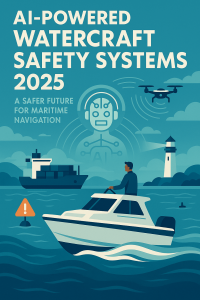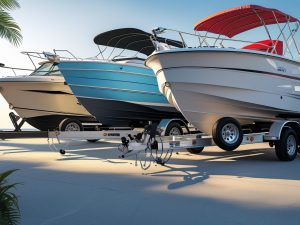In 2025, the boating industry continues to thrive with more people embracing marine recreation and water sports. For many boat owners, upgrading to a newer model means trading in their current vessel. But getting a fair trade-in value for a used boat can be a daunting task—especially with fluctuating market conditions and evolving buyer expectations.
This guide aims to break down the entire trade-in process, help you understand what affects your boat’s value, and how to maximize the amount you receive during trade-in.
Understanding Boat Trade-In Value
Boat trade-in value refers to the amount a dealership or broker is willing to offer for your used boat, which can then be applied as credit towards a new boat purchase. It’s essentially the marine equivalent of trading in your car.
There are generally three types of boat values you should know:
-
Retail Value: The price a boat sells for in the open market.
-
Trade-In Value: The price a dealer will offer you when trading in.
-
Wholesale Value: What a dealer might pay at auction or between dealers.
The trade-in value is typically lower than retail but includes convenience factors such as reduced marketing and time-to-sale.
Why Trade in Your Used Boat in 2025?
There are several reasons why 2025 is an ideal time to consider trading in your used boat:
-
Increased demand: The pandemic-induced boating boom is still influencing demand.
-
Technological advances: New boats in 2025 feature improved fuel efficiency, AI navigation, and eco-friendly motors.
-
Dealer incentives: Many dealerships are offering strong trade-in bonuses to encourage new purchases.
Trading in offers a simple, hassle-free way to move up to a newer model without the challenges of a private sale.
Key Factors That Affect Used Boat Trade-In Value
The value you receive for your used boat depends on a variety of elements. Understanding these helps you take control of the valuation process.
1. Make and Model
Some brands, such as Sea Ray, Boston Whaler, and Yamaha, hold value better than others due to reputation and quality.
2. Year of Manufacture
Newer boats naturally command higher trade-in values. However, well-maintained older boats with upgraded systems can also retain value.
3. Condition of the Boat
-
Exterior: Hull damage, scratches, and gel coat fading lower value.
-
Interior: Mold, upholstery wear, and cabin condition matter.
-
Mechanical: Engine performance, hours used, and service history play a significant role.
4. Engine Hours
Boats with fewer engine hours generally fetch higher values. An average of 50–100 hours per year is considered normal.
5. Upgrades and Accessories
Modern electronics, trolling motors, sound systems, fish finders, and dual engines can increase your trade-in value.
6. Market Demand
Boats in high-demand categories (like center consoles, pontoon boats, or ski boats) tend to receive better offers.
How to Accurately Estimate Your Boat’s Value
Before walking into a dealership, get a solid estimate of your boat’s worth. Here are tools and resources to help:
1. NADA Guides (J.D. Power)
The most widely used reference in the industry. Visit NADA Guides and input your boat’s details.
2. Boat Trader and YachtWorld
Browse listings to find similar boats and compare pricing.
3. Marine Surveyors
Hiring a marine surveyor can offer a detailed valuation, especially for high-end vessels.
4. Dealership Appraisal
Many dealerships will give you a no-obligation appraisal. Use this as a benchmark to compare offers.
Current Market Trends for Boat Values in 2025
Here’s what’s influencing boat trade-in values in 2025:
-
Sustainability Push: Electric and hybrid boats are trending. Traditional gas-powered boats may see reduced value.
-
Luxury Growth: High-end boat models are outperforming entry-level boats in terms of resale.
-
Inflation Impact: Raw material costs and labor shortages are still influencing new boat prices, which boosts used boat values.
-
Demand for Smaller Boats: Due to fuel economy, smaller and mid-size boats are increasingly preferred.
Best Time to Trade in a Used Boat
Timing matters when trying to maximize trade-in value. Here are the best windows in 2025:
-
Spring (March to May): Start of boating season. Dealers are actively buying.
-
Early Fall (September): Many buyers look for end-of-season deals.
-
Boat Shows: Events in February and October offer promotions and bonuses for trade-ins.
Where to Trade in Your Boat
You can trade in your used boat at several types of establishments:
1. Authorized Dealerships
These typically offer the most seamless trade-in process and may offer promotional pricing.
2. Boat Shows and Expos
Great places to see multiple offers and options at once.
3. Online Boat Dealers
Websites like Boats.com, Boat Trader, and Pop Yachts offer trade-in programs.
4. Local Marinas and Brokers
Some marinas or individual brokers offer trade-in credit for upgrade deals.
Maximizing the Trade-In Value of Your Boat
Here’s how to squeeze the most value out of your boat when trading in:
1. Clean Thoroughly
Detailing your boat can make a significant difference. Polish the exterior, clean the interior, and fix minor cosmetic issues.
2. Keep Maintenance Records
A complete service log demonstrates good care and adds to resale value.
3. Repair Critical Systems
Ensure engine, electrical, and plumbing systems are operational.
4. Bundle Accessories
Present your boat as a turn-key package with all accessories included.
5. Negotiate Wisely
Get multiple appraisals, and don’t hesitate to walk away from a low offer.
Boat Trade-In vs Selling Privately
| Feature | Trade-In | Private Sale |
|---|---|---|
| Convenience | High | Low |
| Time to Sell | Instant or within days | Weeks to months |
| Price Received | Lower than retail | Higher than trade-in |
| Risk & Paperwork | Minimal (dealer handles) | High (you handle all paperwork) |
| Tax Benefit | Often reduces sales tax on new boat | No tax benefit |
While selling privately can net you more cash, trading in is faster and hassle-free—ideal for buyers looking to upgrade immediately.
Common Mistakes to Avoid
Avoid these pitfalls when trading in your boat:
-
Overestimating Value: Be realistic. Use verified sources for appraisal.
-
Lack of Documentation: No service history or title = lower value.
-
Ignoring Repairs: Leaving mechanical issues unresolved costs more than fixing them.
-
Trading at the Wrong Time: Off-season trades often result in lowball offers.
-
Accepting First Offer: Always get multiple quotes before finalizing.
Frequently Asked Questions (FAQs)
1. How much is my boat worth in 2025?
The value depends on its make, model, year, condition, and market demand. Use NADA Guides, local listings, and dealership appraisals for estimates.
2. Is it better to sell or trade in my boat?
If you’re looking for convenience and are buying another boat, trade-in is ideal. For maximum cash, a private sale is better but takes more effort.
3. Do I pay taxes on a boat trade-in?
In many states, the trade-in amount is deducted from the purchase price of the new boat, lowering your taxable total. Check local tax laws.
4. Can I trade in a financed boat?
Yes, but you must pay off the loan at closing or roll the balance into a new loan. Dealers can assist with this process.
5. What paperwork do I need to trade in my boat?
Bring the boat title, maintenance records, any outstanding loan payoff info, and a government-issued ID.
6. What if my boat has engine problems?
Expect a significantly lower trade-in offer. You may be better off fixing the issue or selling for parts.
7. How long does a trade-in process take?
Typically, 1–3 days from appraisal to agreement. Some dealerships offer same-day deals.
Conclusion
Trading in your used boat in 2025 is a smart move for many boat owners—especially with favorable market conditions, growing demand, and streamlined dealer processes. However, understanding what affects your boat’s value, how to prepare it for trade-in, and when and where to complete the transaction is crucial to maximizing your return.







